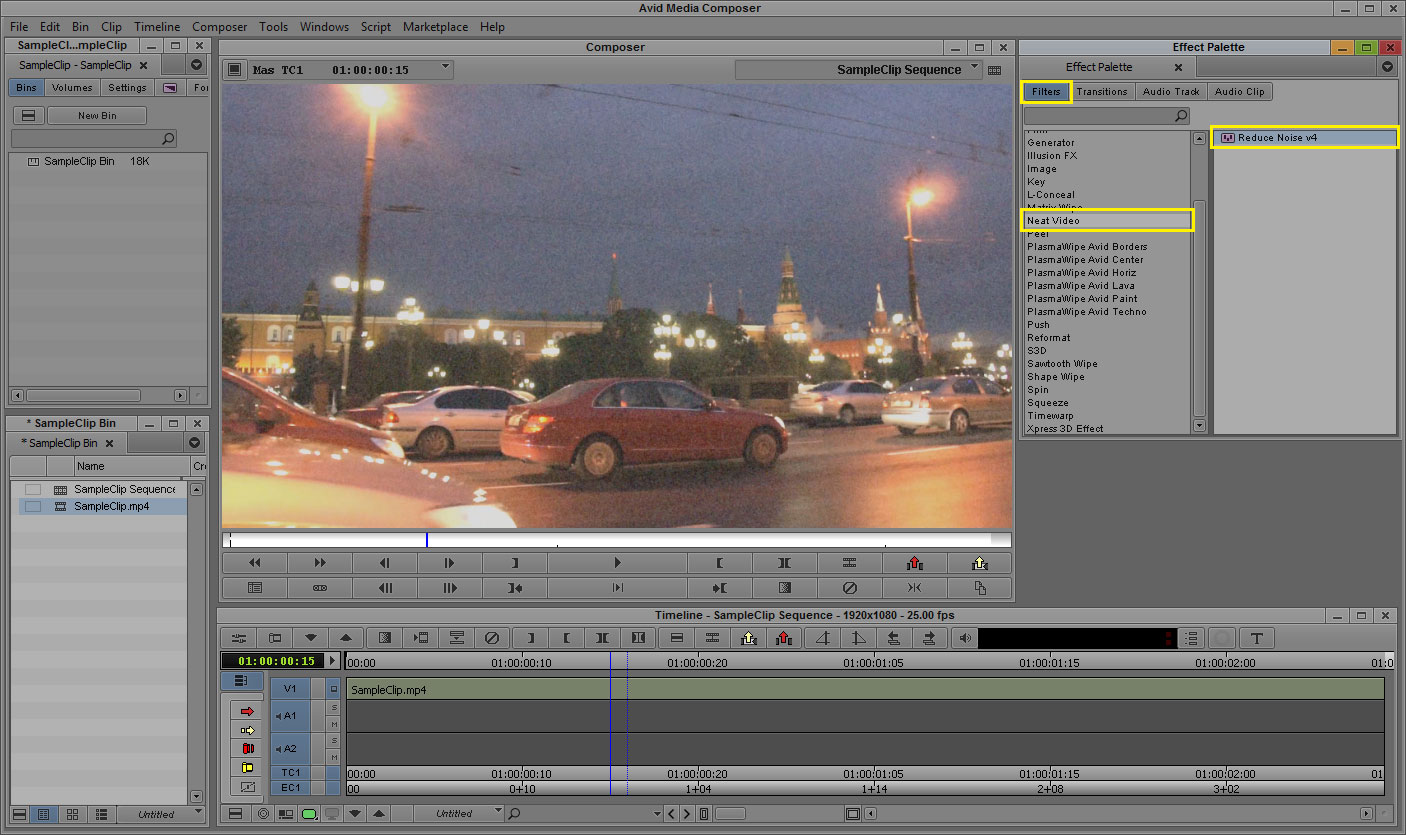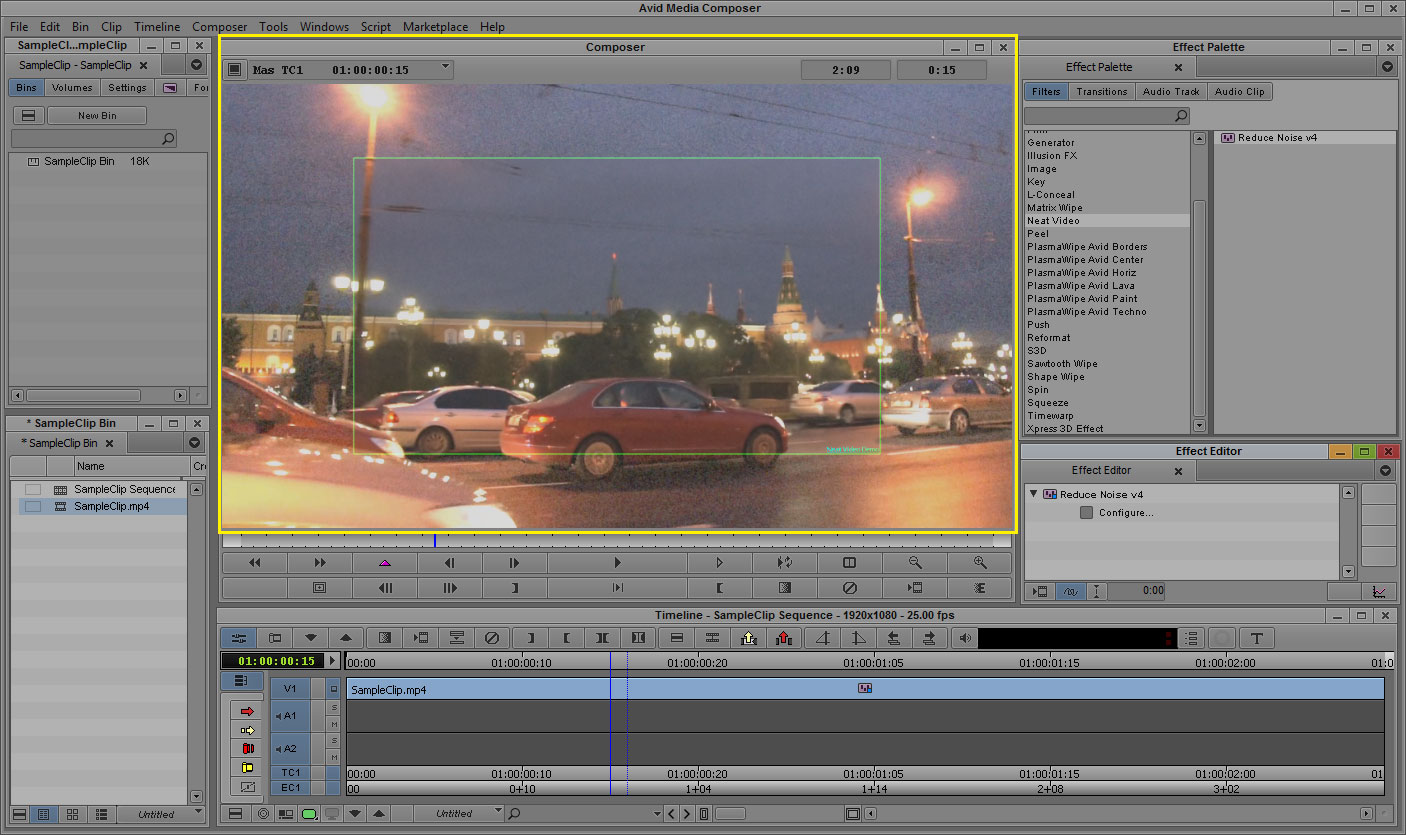Quick Start Guide — Media Composer
This guide is for Neat Video v4 plug-in for AVX hosts being used with Avid Media Composer 8.8.
If you use another Neat Video plug-in or another editing application, please select the corresponding quick start guide.
1. Installing the plug-in
To install the Neat Video plug-in for Media Composer:
-
Make sure you have started Media Composer at least once before installing the plug-in. If you have not done that yet, start Media Composer and exit it.
- Download the installer of Neat Video for AVX hosts:
- If you already purchased the product and have a current license for the Pro plug-in, please download the Pro plug-in from My Products page
- If you want to try Neat Video before purchase, please download the Demo plug-in from Download page
- Start the installer:
For Windows:
Double-click the downloaded EXE file to start the installer
For Mac OS X:
a. Double-click the downloaded DMG file to mount the volume
b. In the mounted volume, double-click NeatVideoAVX.Intel.pkg to start the installer
(you may be prompted to enter the Name / Password of the OSX administrator account)
-
Proceed through the steps of the installation process. Use the default settings offered by the installer. This should automatically make the plug-in available to Media Composer.
- Start Media Composer and find Neat VIdeo > Reduce Noise v4 in the Media Composer’s Effect Palette.
In case the plug-in has not become available in Media Composer, please contact Neat Video support for assistance.
2. Running Neat Video on a sample video clip
Please download the test-kit prepared to help you start using Neat Video. Having downloaded, please unzip it to a new folder on the hard disk.
The test-kit includes a sample video clip: SampleClip.mp4. This is a typical video clip captured by a digital video camera in high-gain mode. Some technical information about the sample clip is available in the SampleClipInfo.txt file.
Please start Media Composer and go through the steps below to clean the clip using Neat Video.
2.1. Add the sample clip to the project
1. Configure a new project in Media Composer
Create a new project called “SampleClip” in Media Composer and select the “1080p/25” format. Then click the Ok buttons and Media Composer will open the new project with the Timeline, Composer, Bin and other windows:

2. Add the sample clip file to the project
Use the File > Input > Import Media... menu in Media Composer to import the SampleClip.mp4 file into SampleClip Вin:

3. Add the sample clip to the composition
- Use Timeline > New > Sequence menu to create a new sequence called “SampleClip Sequence”:

- Select the sample clip in the SampleClip Bin window and drag-n-drop the clip in the Timeline – SampleClip Sequence window.

- Select the Full Quality option in Video Quality Menu in the Timeline window.

2.2. Add Neat Video to the composition
- Use Tools > Effect Palette menu to open the list of available video effects:

- Select Neat Video > Reduce Noise v4 in the list and drag-n-drop the effect in the Timeline window on top of the sample clip:

- Use Tools > Effect Editor menu to open Effect Editor window:

2.3. Configure Neat Video
1. Open Neat Video plug-in window
- Use the Timeline controls to select a frame with large flat featureless areas; the selected frame will be used for noise analysis in the next stages.
-
In the Effect Editor window, click the Configure... button to open the main Neat Video plug-in window.
(If you run the Demo plug-in, click Ok in the popup splash screen of the plug-in to proceed further).

The Neat Video plug-in window will open and display the current frame from the clip:

2. Build a noise profile for the clip
To reduce noise in this frame and in the whole clip, Neat Video generally needs a noise profile describing the noise properties of the clip. You can prepare such a profile using the Auto Profile function:
-
In the Device Noise Profile tab
 click
click 
Neat Video will then automatically analyze the noise to build a new noise profile:

- Visually inspect the selected area — it should contain no visible details, only noise; otherwise the noise profile and subsequent noise reduction may be inaccurate.
If the selected area does contain any details, move the selection to a featureless area or simply draw a new selection in such an area (the selection must be at least 32x32 pixels large). Then click the Auto Profile button again.
After that Neat Video is ready to filter the clip.
3. Check Preview
-
Switch to the Noise Filter Settings tab

You will notice that Neat Video has already applied noise reduction based on the default filter settings and the preview shows a clearly visible difference: there is less noise than in the original frame.
You can try to adjust the filter settings and see how that affects the results. For example, try to adjust the Temporal Filter > Radius setting (in the Temporal tab in the Filter Settings box in the right part of the window) from 2 to 1 or to a higher value. This will apply weaker or stronger temporal noise reduction to the frame.

4. Apply the changes
-
Click
 in the bottom of the plug-in window.
in the bottom of the plug-in window.
Neat Video will save the current settings and close its main window.
(If you run the Demo plug-in, it will also describe the limitations of the Demo version at this point).
Once this step is completed and Neat Video window is closed, the filter is ready for work.
The preview in Media Composer now shows the clip with noise reduction applied to it:

2.4. Render the video
To apply Neat Video noise reduction
- Use the Timeline > Render > Render At Position... menu item in Media Composer to prepare and evaluate a preview.
Media Composer will then apply Neat Video noise reduction to the whole sample clip to help you evaluate the filtration results (and adjust the filter settings if necessary). You will see that the noise in the resulting clip is significantly reduced while the true details are preserved.
Please see the User Guide (Win) and User Guide (OS X) for more details about adjusting the filter settings and other aspects of using Neat Video. These Video Tutorials will also help you to get the most out of Neat Video noise reduction.
